YAMAHA TDM 850 2001 Repair Manual
Manufacturer: YAMAHA, Model Year: 2001, Model line: TDM 850, Model: YAMAHA TDM 850 2001Pages: 110, PDF Size: 12.15 MB
Page 61 of 110
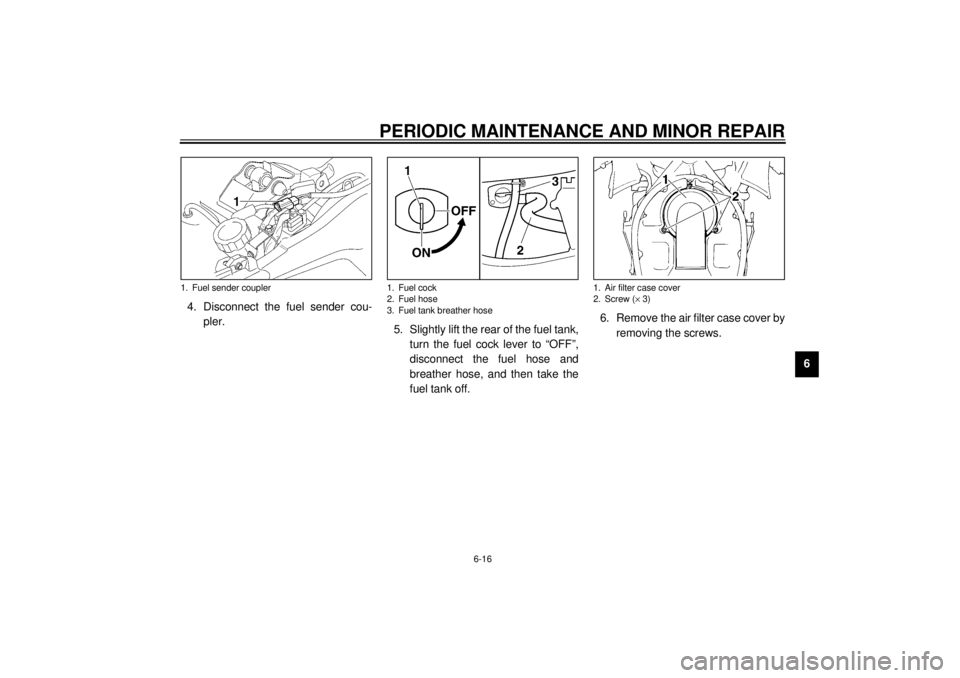
PERIODIC MAINTENANCE AND MINOR REPAIR
6-16
6 4. Disconnect the fuel sender cou-
pler.
5. Slightly lift the rear of the fuel tank,
turn the fuel cock lever to “OFF”,
disconnect the fuel hose and
breather hose, and then take the
fuel tank off.6. Remove the air filter case cover by
removing the screws.
1. Fuel sender coupler
1. Fuel cock
2. Fuel hose
3. Fuel tank breather hose
1. Air filter case cover
2. Screw (´ 3)
E_4tx.book Page 16 Wednesday, October 4, 2000 4:28 PM
Page 62 of 110
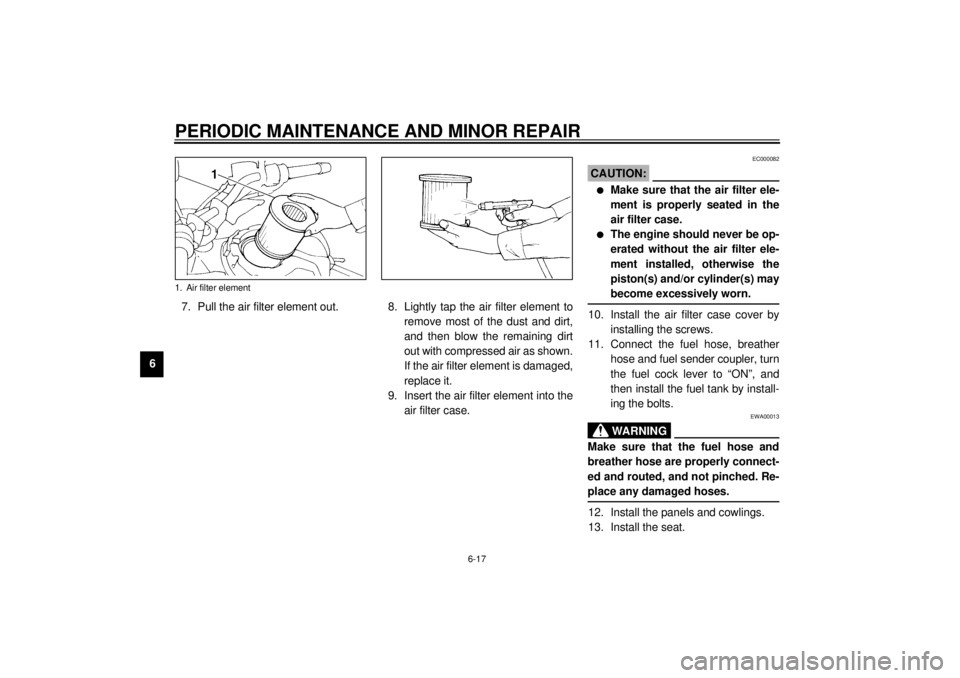
PERIODIC MAINTENANCE AND MINOR REPAIR
6-17
67. Pull the air filter element out. 8. Lightly tap the air filter element to
remove most of the dust and dirt,
and then blow the remaining dirt
out with compressed air as shown.
If the air filter element is damaged,
replace it.
9. Insert the air filter element into the
air filter case.
EC000082
CAUTION:@ l
Make sure that the air filter ele-
ment is properly seated in the
air filter case.
l
The engine should never be op-
erated without the air filter ele-
ment installed, otherwise the
piston(s) and/or cylinder(s) may
become excessively worn.
@10. Install the air filter case cover by
installing the screws.
11. Connect the fuel hose, breather
hose and fuel sender coupler, turn
the fuel cock lever to “ON”, and
then install the fuel tank by install-
ing the bolts.
EWA00013
WARNING
@ Make sure that the fuel hose and
breather hose are properly connect-
ed and routed, and not pinched. Re-
place any damaged hoses. @12. Install the panels and cowlings.
13. Install the seat.
1. Air filter elementE_4tx.book Page 17 Wednesday, October 4, 2000 4:28 PM
Page 63 of 110
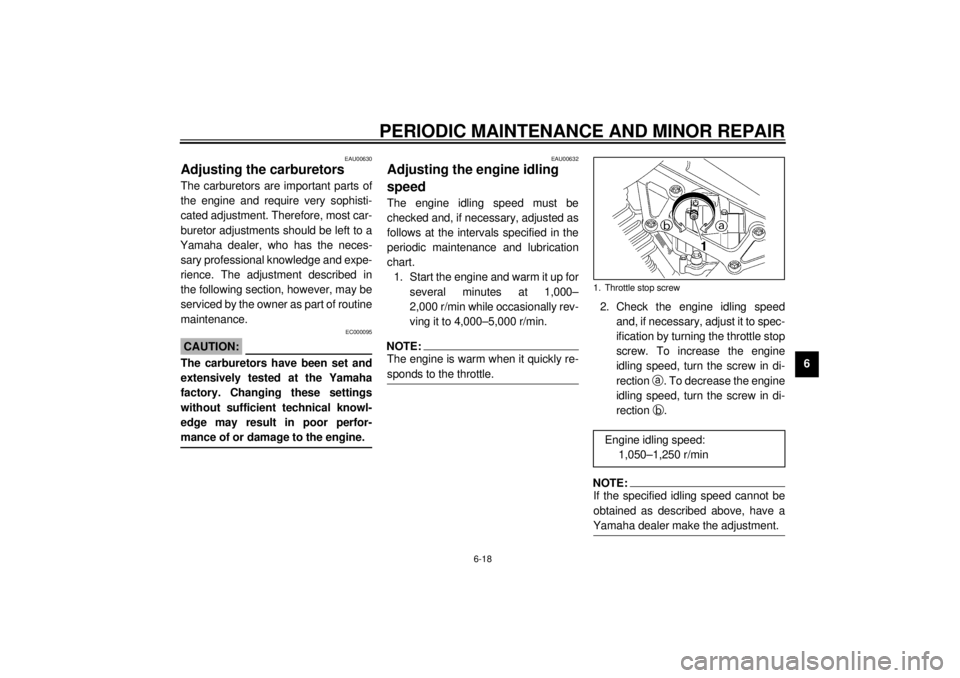
PERIODIC MAINTENANCE AND MINOR REPAIR
6-18
6
EAU00630
Adjusting the carburetors The carburetors are important parts of
the engine and require very sophisti-
cated adjustment. Therefore, most car-
buretor adjustments should be left to a
Yamaha dealer, who has the neces-
sary professional knowledge and expe-
rience. The adjustment described in
the following section, however, may be
serviced by the owner as part of routine
maintenance.
EC000095
CAUTION:@ The carburetors have been set and
extensively tested at the Yamaha
factory. Changing these settings
without sufficient technical knowl-
edge may result in poor perfor-
mance of or damage to the engine. @
EAU00632
Adjusting the engine idling
speed The engine idling speed must be
checked and, if necessary, adjusted as
follows at the intervals specified in the
periodic maintenance and lubrication
chart.
1. Start the engine and warm it up for
several minutes at 1,000–
2,000 r/min while occasionally rev-
ving it to 4,000–5,000 r/min.NOTE:@ The engine is warm when it quickly re-
sponds to the throttle. @
2. Check the engine idling speed
and, if necessary, adjust it to spec-
ification by turning the throttle stop
screw. To increase the engine
idling speed, turn the screw in di-
rection
a. To decrease the engine
idling speed, turn the screw in di-
rection
b.NOTE:@ If the specified idling speed cannot be
obtained as described above, have a
Yamaha dealer make the adjustment. @ 1. Throttle stop screwEngine idling speed:
1,050–1,250 r/min
E_4tx.book Page 18 Wednesday, October 4, 2000 4:28 PM
Page 64 of 110
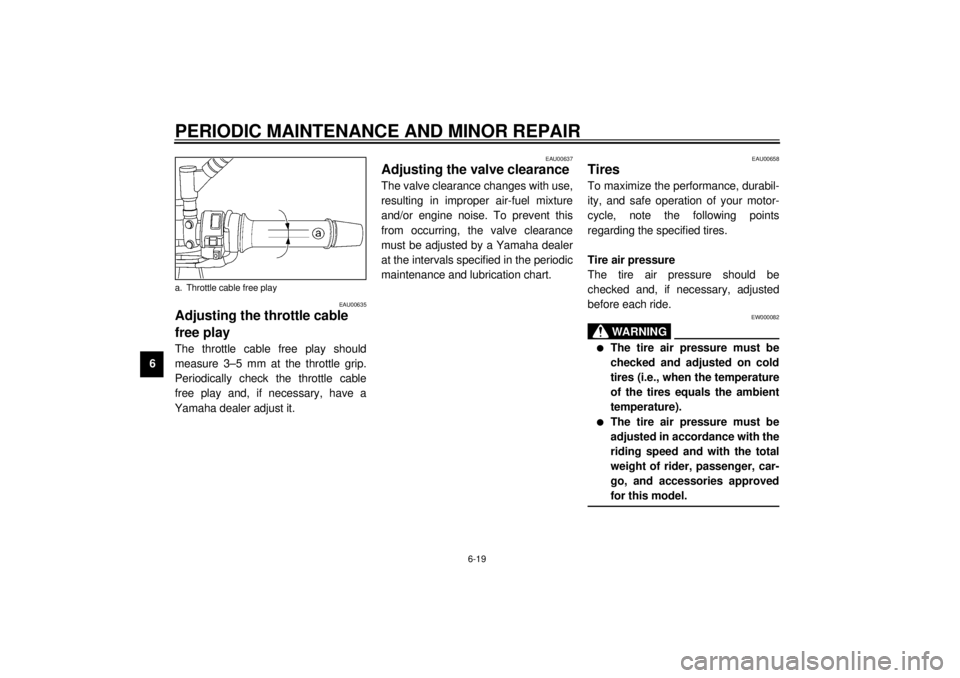
PERIODIC MAINTENANCE AND MINOR REPAIR
6-19
6
EAU00635
Adjusting the throttle cable
free play The throttle cable free play should
measure 3–5 mm at the throttle grip.
Periodically check the throttle cable
free play and, if necessary, have a
Yamaha dealer adjust it.
EAU00637
Adjusting the valve clearance The valve clearance changes with use,
resulting in improper air-fuel mixture
and/or engine noise. To prevent this
from occurring, the valve clearance
must be adjusted by a Yamaha dealer
at the intervals specified in the periodic
maintenance and lubrication chart.
EAU00658
Tires To maximize the performance, durabil-
ity, and safe operation of your motor-
cycle, note the following points
regarding the specified tires.
Tire air pressure
The tire air pressure should be
checked and, if necessary, adjusted
before each ride.
EW000082
WARNING
_ l
The tire air pressure must be
checked and adjusted on cold
tires (i.e., when the temperature
of the tires equals the ambient
temperature).
l
The tire air pressure must be
adjusted in accordance with the
riding speed and with the total
weight of rider, passenger, car-
go, and accessories approved
for this model.
_
a. Throttle cable free playE_4tx.book Page 19 Wednesday, October 4, 2000 4:28 PM
Page 65 of 110
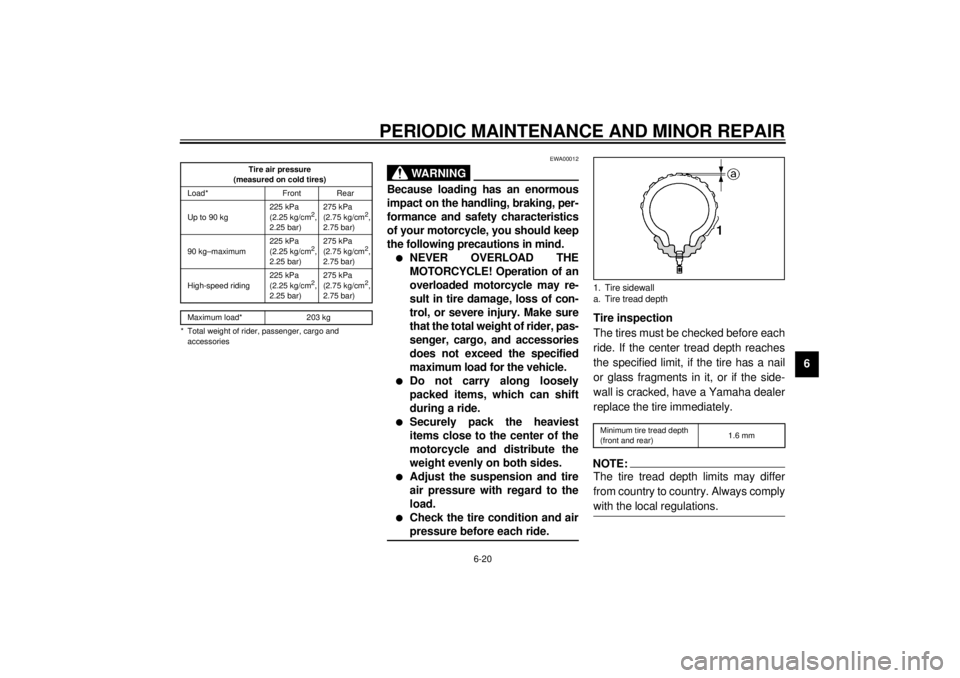
PERIODIC MAINTENANCE AND MINOR REPAIR
6-20
6
CE-01E
CE-07EEWA00012
WARNING
_ Because loading has an enormous
impact on the handling, braking, per-
formance and safety characteristics
of your motorcycle, you should keep
the following precautions in mind. l
NEVER OVERLOAD THE
MOTORCYCLE! Operation of an
overloaded motorcycle may re-
sult in tire damage, loss of con-
trol, or severe injury. Make sure
that the total weight of rider, pas-
senger, cargo, and accessories
does not exceed the specified
maximum load for the vehicle.
l
Do not carry along loosely
packed items, which can shift
during a ride.
l
Securely pack the heaviest
items close to the center of the
motorcycle and distribute the
weight evenly on both sides.
l
Adjust the suspension and tire
air pressure with regard to the
load.
l
Check the tire condition and air
pressure before each ride.
_
Tire inspection
The tires must be checked before each
ride. If the center tread depth reaches
the specified limit, if the tire has a nail
or glass fragments in it, or if the side-
wall is cracked, have a Yamaha dealer
replace the tire immediately.CE-08ENOTE:_ The tire tread depth limits may differ
from country to country. Always comply
with the local regulations. _
Tire air pressure
(measured on cold tires)
Load* Front Rear
Up to 90 kg225 kPa
(2.25 kg/cm
2,
2.25 bar)275 kPa
(2.75 kg/cm
2,
2.75 bar)
90 kg–maximum225 kPa
(2.25 kg/cm
2,
2.25 bar)275 kPa
(2.75 kg/cm
2,
2.75 bar)
High-speed riding225 kPa
(2.25 kg/cm
2,
2.25 bar)275 kPa
(2.75 kg/cm
2,
2.75 bar)
Maximum load* 203 kg
* Total weight of rider, passenger, cargo and
accessories
1. Tire sidewall
a. Tire tread depthMinimum tire tread depth
(front and rear)1.6 mm
E_4tx.book Page 20 Wednesday, October 4, 2000 4:28 PM
Page 66 of 110
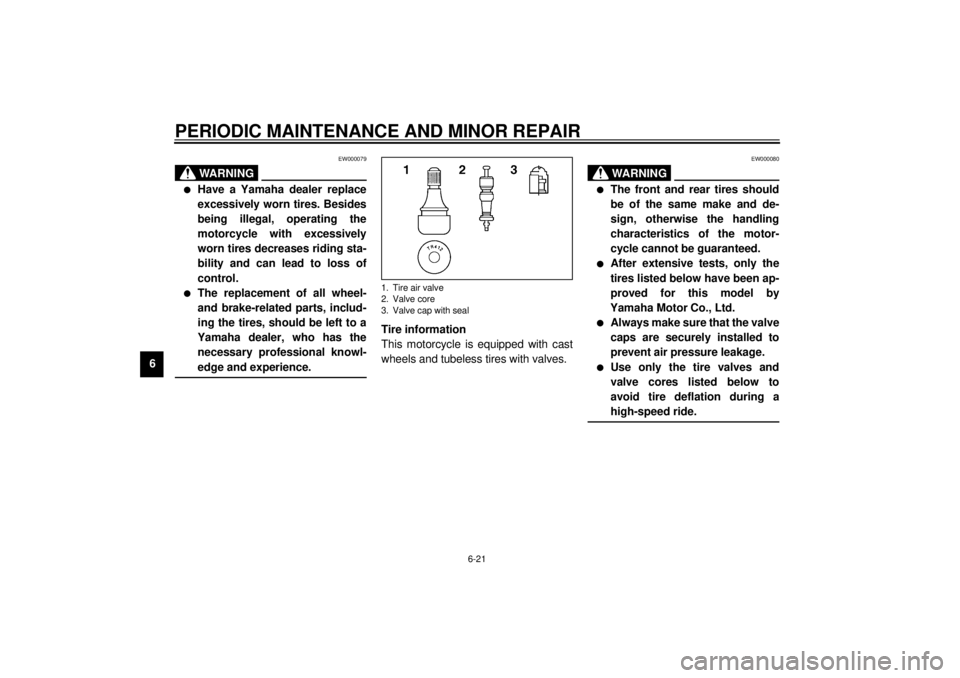
PERIODIC MAINTENANCE AND MINOR REPAIR
6-21
6
EW000079
WARNING
_ l
Have a Yamaha dealer replace
excessively worn tires. Besides
being illegal, operating the
motorcycle with excessively
worn tires decreases riding sta-
bility and can lead to loss of
control.
l
The replacement of all wheel-
and brake-related parts, includ-
ing the tires, should be left to a
Yamaha dealer, who has the
necessary professional knowl-
edge and experience.
_
Tire information
This motorcycle is equipped with cast
wheels and tubeless tires with valves.
EW000080
WARNING
_ l
The front and rear tires should
be of the same make and de-
sign, otherwise the handling
characteristics of the motor-
cycle cannot be guaranteed.
l
After extensive tests, only the
tires listed below have been ap-
proved for this model by
Yamaha Motor Co., Ltd.
l
Always make sure that the valve
caps are securely installed to
prevent air pressure leakage.
l
Use only the tire valves and
valve cores listed below to
avoid tire deflation during a
high-speed ride.
_
1. Tire air valve
2. Valve core
3. Valve cap with seal
E_4tx.book Page 21 Wednesday, October 4, 2000 4:28 PM
Page 67 of 110
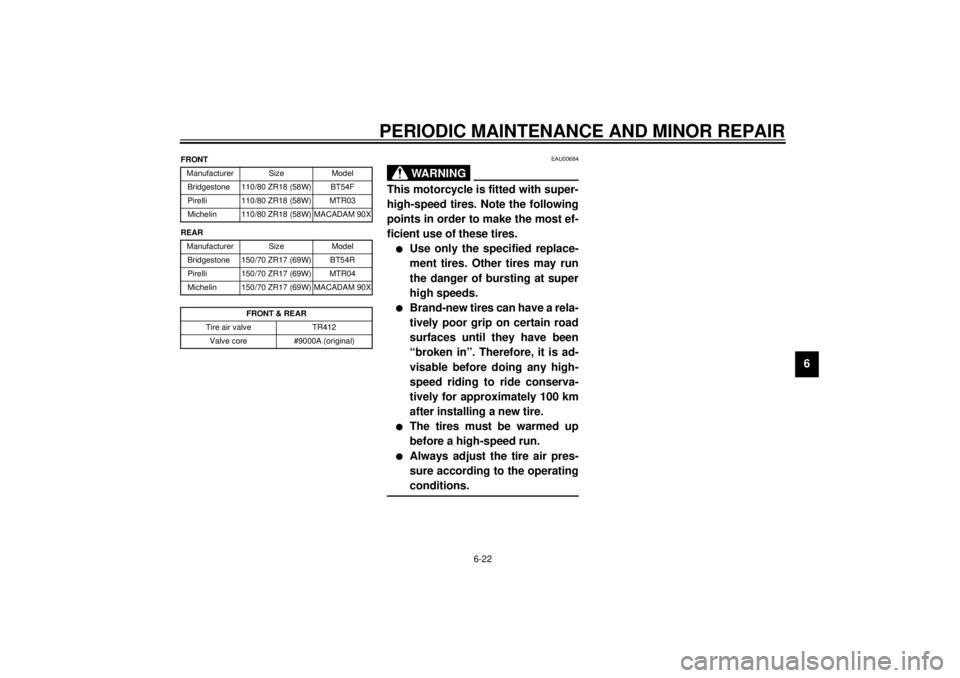
PERIODIC MAINTENANCE AND MINOR REPAIR
6-22
6
CE-10E
CE-14EEAU00684
WARNING
@ This motorcycle is fitted with super-
high-speed tires. Note the following
points in order to make the most ef-
ficient use of these tires.l
Use only the specified replace-
ment tires. Other tires may run
the danger of bursting at super
high speeds.
l
Brand-new tires can have a rela-
tively poor grip on certain road
surfaces until they have been
“broken in”. Therefore, it is ad-
visable before doing any high-
speed riding to ride conserva-
tively for approximately 100 km
after installing a new tire.
l
The tires must be warmed up
before a high-speed run.
l
Always adjust the tire air pres-
sure according to the operating
conditions.
@
FRONT
Manufacturer Size Model
Bridgestone 110/80 ZR18 (58W) BT54F
Pirelli 110/80 ZR18 (58W) MTR03
Michelin 110/80 ZR18 (58W) MACADAM 90X
REAR
Manufacturer Size Model
Bridgestone 150/70 ZR17 (69W) BT54R
Pirelli 150/70 ZR17 (69W) MTR04
Michelin 150/70 ZR17 (69W) MACADAM 90X
FRONT & REAR
Tire air valve TR412
Valve core #9000A (original)
E_4tx.book Page 22 Wednesday, October 4, 2000 4:28 PM
Page 68 of 110
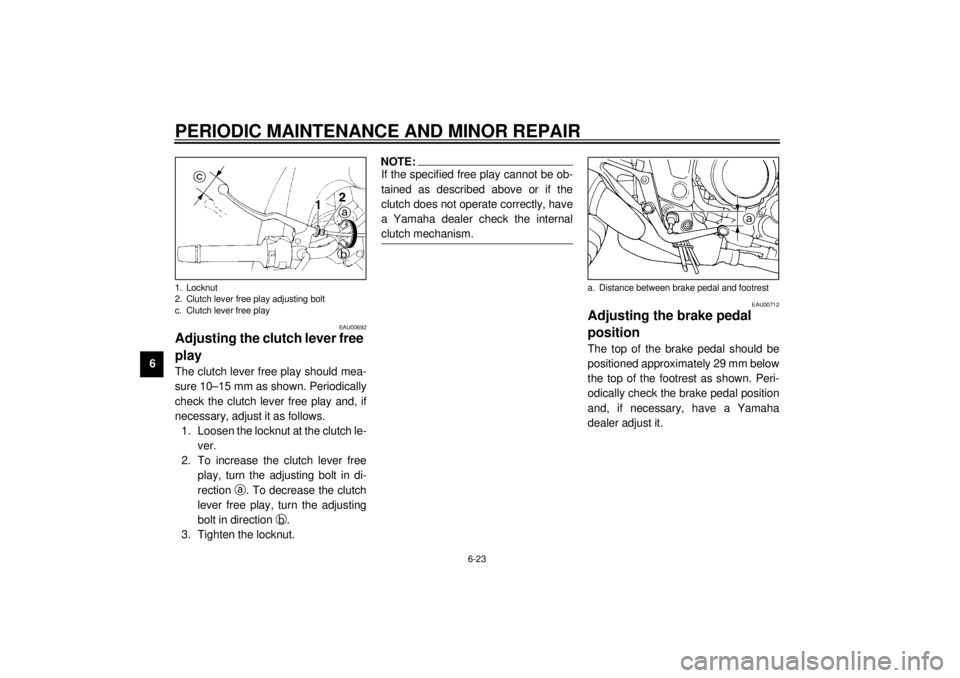
PERIODIC MAINTENANCE AND MINOR REPAIR
6-23
6
EAU00692
Adjusting the clutch lever free
play The clutch lever free play should mea-
sure 10–15 mm as shown. Periodically
check the clutch lever free play and, if
necessary, adjust it as follows.
1. Loosen the locknut at the clutch le-
ver.
2. To increase the clutch lever free
play, turn the adjusting bolt in di-
rection
a. To decrease the clutch
lever free play, turn the adjusting
bolt in direction
b.
3. Tighten the locknut.
NOTE:@ If the specified free play cannot be ob-
tained as described above or if the
clutch does not operate correctly, have
a Yamaha dealer check the internal
clutch mechanism. @
EAU00712
Adjusting the brake pedal
position The top of the brake pedal should be
positioned approximately 29 mm below
the top of the footrest as shown. Peri-
odically check the brake pedal position
and, if necessary, have a Yamaha
dealer adjust it.
1. Locknut
2. Clutch lever free play adjusting bolt
c. Clutch lever free play
a. Distance between brake pedal and footrest
E_4tx.book Page 23 Wednesday, October 4, 2000 4:28 PM
Page 69 of 110
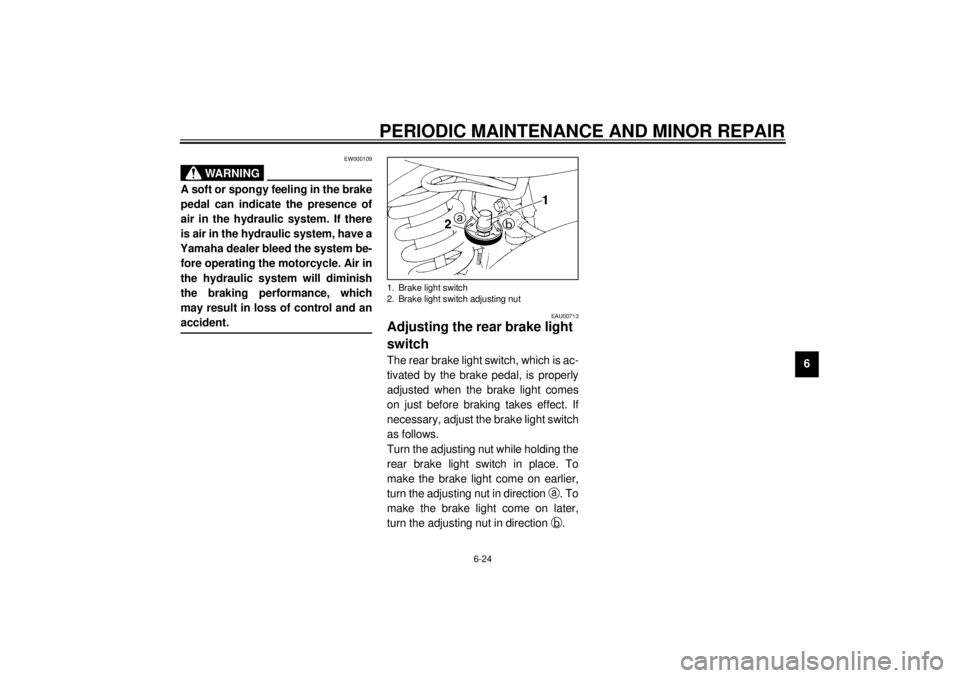
PERIODIC MAINTENANCE AND MINOR REPAIR
6-24
6
EW000109
WARNING
@ A soft or spongy feeling in the brake
pedal can indicate the presence of
air in the hydraulic system. If there
is air in the hydraulic system, have a
Yamaha dealer bleed the system be-
fore operating the motorcycle. Air in
the hydraulic system will diminish
the braking performance, which
may result in loss of control and an
accident. @
EAU00713
Adjusting the rear brake light
switch The rear brake light switch, which is ac-
tivated by the brake pedal, is properly
adjusted when the brake light comes
on just before braking takes effect. If
necessary, adjust the brake light switch
as follows.
Turn the adjusting nut while holding the
rear brake light switch in place. To
make the brake light come on earlier,
turn the adjusting nut in direction
a. To
make the brake light come on later,
turn the adjusting nut in direction
b.1. Brake light switch
2. Brake light switch adjusting nut
E_4tx.book Page 24 Wednesday, October 4, 2000 4:28 PM
Page 70 of 110
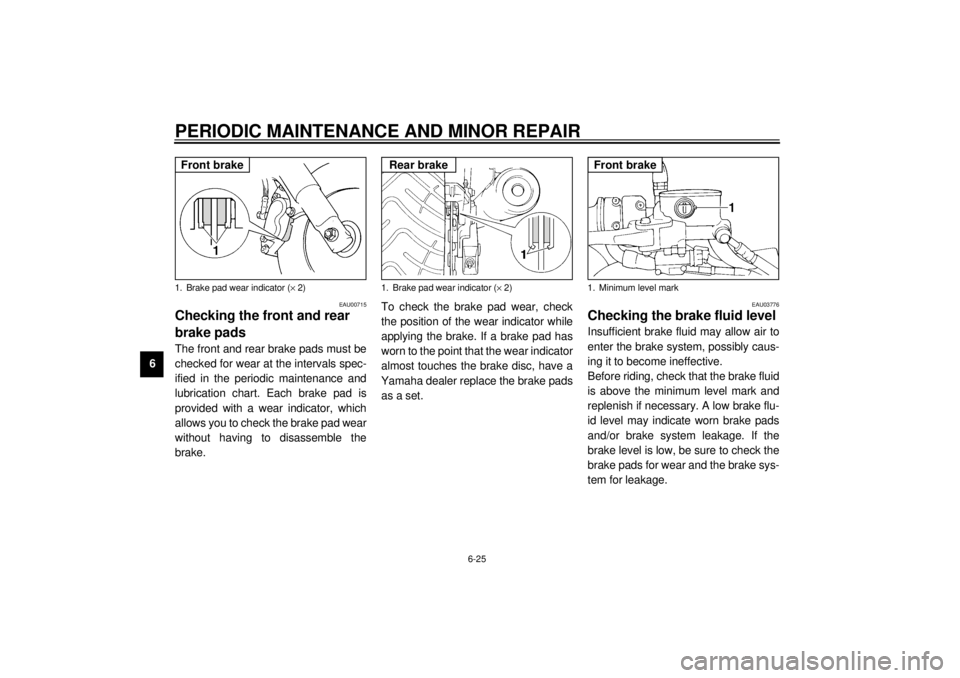
PERIODIC MAINTENANCE AND MINOR REPAIR
6-25
6
EAU00715
Checking the front and rear
brake pads The front and rear brake pads must be
checked for wear at the intervals spec-
ified in the periodic maintenance and
lubrication chart. Each brake pad is
provided with a wear indicator, which
allows you to check the brake pad wear
without having to disassemble the
brake. To check the brake pad wear, check
the position of the wear indicator while
applying the brake. If a brake pad has
worn to the point that the wear indicator
almost touches the brake disc, have a
Yamaha dealer replace the brake pads
as a set.
EAU03776
Checking the brake fluid level Insufficient brake fluid may allow air to
enter the brake system, possibly caus-
ing it to become ineffective.
Before riding, check that the brake fluid
is above the minimum level mark and
replenish if necessary. A low brake flu-
id level may indicate worn brake pads
and/or brake system leakage. If the
brake level is low, be sure to check the
brake pads for wear and the brake sys-
tem for leakage.
1. Brake pad wear indicator (´ 2)Front brake
1. Brake pad wear indicator (´ 2)Rear brake
1. Minimum level markFront brake
E_4tx.book Page 25 Wednesday, October 4, 2000 4:28 PM